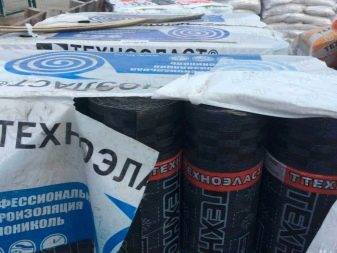Subtleties of installation
The first step in installing waterproofing should be the preparation of the base, the thoroughness of which depends on the material of the floor and the method of waterproofing. To do this, it is necessary to dismantle the old coating, remove mechanical debris and dust the base. Then, using a sand-cement mortar, you need to cover up large cracks, cracks and chips.
Next, you should prime the base and let the solution soak and dry. An exception is the installation of waterproofing using shield materials: in this case, priming the surface is not a prerequisite for preparing the floor.
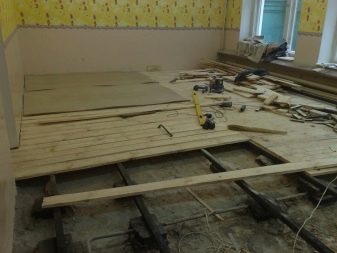
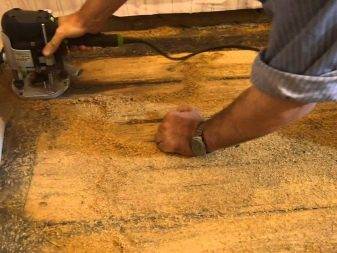
After the surface is completely ready for work, you can start installing the waterproofing agent. If bituminous mastic is used, the material should be applied in several layers, applying each subsequent layer perpendicular to the previous one and only after the latter has completely dried. The joints in the coating should be pre-sealed with a sealing tape. After the top layer dries, you can start forming the screed or laying the topcoat. Consumption of bitumen mastic will be 3 kg / m2.
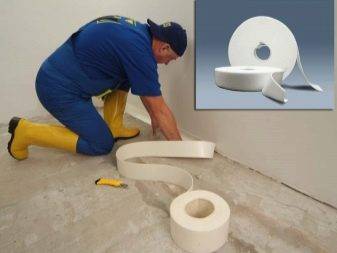
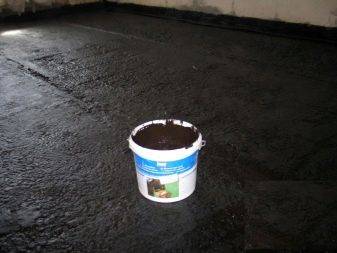
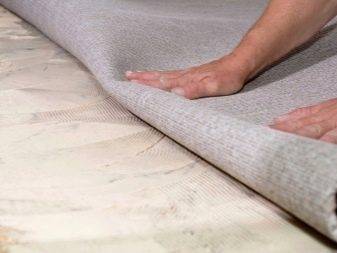
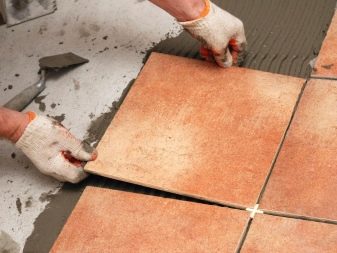
You can prepare the plaster waterproofing mixture yourself. To do this, you need to mix cement with sand in a ratio of 1: 2 and prepare a solution that is traditional in consistency. A damper tape should be glued to the lower edge of the walls, which will play the role of a compensator when the waterproofing layer expands-narrows. Then 3-4 layers of the composition are applied to a carefully prepared dry floor with a time interval of 15 minutes after each layer.
Then, every three hours during the day, the "cake" is moistened. Installation of the topcoat can be started no earlier than 48 hours after installation.

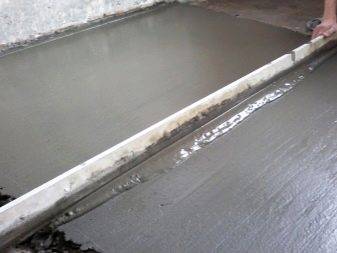
Roll materials require a carefully prepared surface. If the base is crooked and has numerous defects, it is recommended to level it with a self-leveling mixture. Then an adhesive solution in the form of polymer mastic or bitumen emulsion should be applied to the base. In this case, there is no need to cover the entire floor entirely, it is enough to apply diagonal and transverse stripes at some distance from each other.
Next, you need to heat the roll with a gas burner and roll it out on the floor. The edge of the strip adjacent to the wall is also heated and wrapped on the wall with an overlap of 20 cm. The rest of the strips are laid in the same way. The overlap on the adjacent strip should be 15 cm.

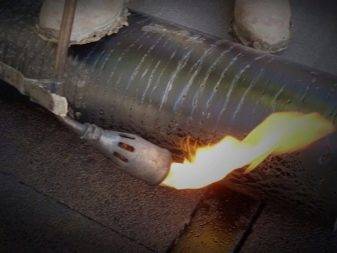
Self-adhesive materials are preheated with a hot air gun. This softens the adhesive base and provides a strong adhesion of the material to the base. Most roll-on waterproofing products are made on the basis of hot bitumen, therefore, when using open flames of gas burners, strict safety measures should be observed.
Liquid waterproofing agents such as paint or special epoxy varnishes should only be applied to primed surfaces. As a primer, it is recommended to use deep penetration agents that are compatible with one or another type of substrate. Application is carried out with a roller or brush.
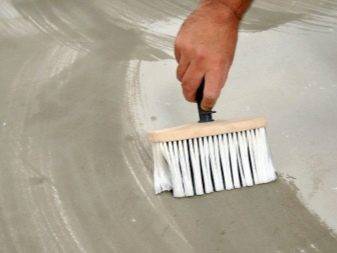
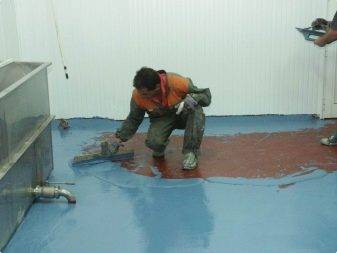
Covering waterproofing device
The surface used for coating is pre-leveled, cleaned and dried. It is necessary to remove all old reinforcement, beads and recesses. All joints are sealed with a sealant and the brickwork is leveled with a sandstone cement screed.
The device of horizontal insulation, like vertical insulation, will require mastic based on polymers, bitumen-rubber, bitumen-polymer or bituminous components.
- The first step is to apply a 1.5 mm layer of mastic to a previously prepared surface, after which rolls of waterproofing material are rolled out and fixed.
- Mastic is also applied over the waterproofing layer. The roll is rolled out gradually, thereby gluing it to the base. If there is a need to create a multi-layer waterproofing, subsequent layers must be applied in the same order and direction.
Rolled waterproofing materials and the rules for their sticker:
- If horizontal waterproofing or vertical waterproofing of a surface longer than 10 m is performed, then additional devices will be needed to apply the base material.
- Do-it-yourself waterproofing on a vertical surface is done using roll materials that must be glued from top to bottom. Cutting the purchased material into measured strips is worth it in advance.
- Laying is done with an overlap. About 10 cm longitudinally and about 20 cm horizontally.
- All edges are putty and finished with an additional layer of mastic. Its thickness should be at least 0.5 cm.
- Horizontal waterproofing should not be subjected to tensile and shear loads. In order to avoid landslides and various mechanical influences, it is recommended to install an additional structure made of reinforced concrete, concrete or brick. Surfaces that need to be protected with cement or silicate materials require a topcoat of bituminous mastic (hot) or other resins with quartz sand.
Polyurethane foam
Waterproofing foam - polyurethane foam, a substance with high chemical stability in the hardened form.
The composition contains polyol, polyisocyanate, surfactants, propellant, catalysts. There are one- and two-component installation waterproofing foams.
Properties
- It fills gaps and voids between various elements of building structures, increasing their level of waterproofing and strength indicators, because foam is a substance of high rigidity. Due to the foamed structure, the volume after application increases significantly.
- The foam can be applied with an applicator gun. This allows you to dose portions and speeds up the process.
- At low temperatures, special waterproofing foam in aerosols is relevant.
- The two-component version of the foam quickly fixes elements of various structures. This is possible thanks to the fast setting (30 minutes).
- The foam's resistance to mechanical stress increases the waterproofing performance.
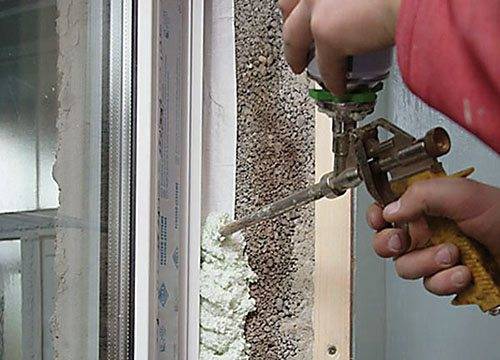
Foam for waterproofing and installation
When is waterproofing indispensable?
There are several reasons why waterproofing is simply necessary, otherwise troubles may arise:
- Groundwater is located less than 1 m before the base of the foundation. In this case, there is a great chance of raising groundwater, especially during the period when the snow is melting.
- Groundwater is located above the bottom elevation of the foundation. In this case, waterproofing is simply necessary, otherwise the lower room may be flooded. You also need to do drainage, which will serve as a drainage system. If it is not done, then, as a rule, hydrostatic pressure arises and the foundation can begin to move or topple over.
- The construction of the foundation is carried out on clay soil. In this case, there is a great chance that there is a layer of water in such a soil, since the clay does not allow moisture to pass through itself.
It should be noted that very often they make a mistake, believing that if the groundwater is located much lower than the base of the foundation, then waterproofing can be omitted.However, it should be remembered that the water level can constantly change, and not only in a certain season of the year, but constantly. This may be due to the density of construction in neighboring territories, drainage, asphalting, etc. In order not to run into problems, in this case, it is better to use lining insulation, which is inexpensive in cost and available to everyone.
Types of moisture protection by location
In general, the foundation waterproofing device is divided into three groups:
- horizontal;
- vertical;
- device of the blind area.
Several methods can be applied simultaneously depending on the type of base.
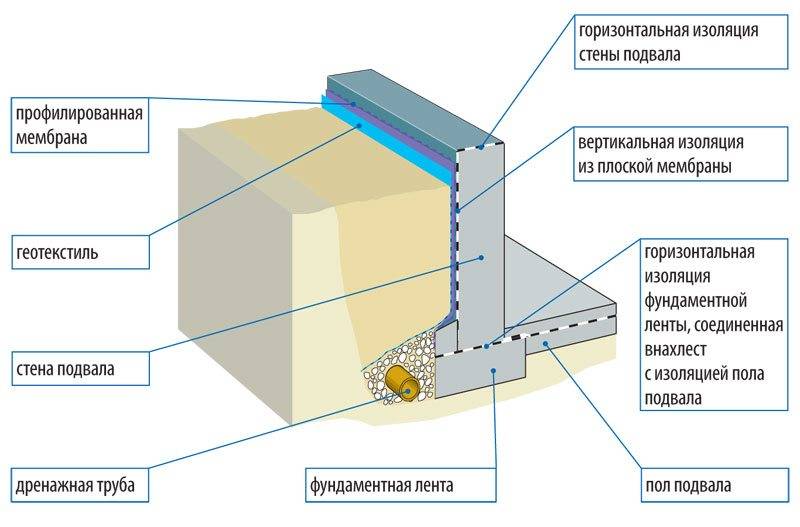 Combined moisture protection
Combined moisture protection
Horizontal is designed to prevent moisture penetration between different levels. It can be made from various materials. Provided for all types of foundations (tapes, slabs, poles, piles).
The vertical one is needed so that groundwater cannot influence the foundation. Not all types of grounds need this protection. Required only for tape and columnar supports at home. Horizontal protection is provided for all types (belt, plate or free-standing supports).
The device of the blind area protects the base from the penetration of rainwater and thawed water in the spring. The width of the structure is essential here. If it is insufficient, then the moisture will be diverted a short distance and will be able to get to the foundation. This type of protection reduces the load on all others, allowing them to increase their service life.
Penetrating waterproofing
Special mixtures of Portland cement, fine quartz or silicate sand and active chemicals, when applied to wet concrete, form insoluble crystals that fill pores and cracks to a depth of 20 cm.
Their validity period is equal to the shelf life of the concrete itself.
Properties
- This penetrating waterproofing compound will extend the life of the building by another 20%.
- Penetrating waterproofing materials are capable of permanent self-healing: crystalline neoplasms resist moisture, corrosion, frost, but allows concrete to breathe.
- This composition is inert, does not emit fumes and does not contain solvents.
Mastic waterproofing
Polymer waterproofing mastic is a viscoplastic mass that is obtained by mixing substances with astringent properties with a finely dispersed base and adhesive additives. Mastic for waterproofing has almost the same properties as adhesives, but belongs to a separate class of materials due to its high viscosity and content of fillers.
Acrylic waterproofing mastic not only connects structural elements to each other, but also covers their surface with a thick layer, which protects them from environmental factors. Liquid mastic (acrylic waterproofing) allows you to fill gaps and holes to ensure the tightness of the joints and the uniformity of the surface. Floor waterproofing is often used.
Also, a mastic waterproofing compound is used as a coating insulation, as a means of gluing elements to a wall or floor, and for gluing roll insulating materials. The device for coating waterproofing is relatively uncomplicated. Lubricating waterproofing can be used to create a vapor-permeable film on the surface, which allows it to be used when processing internal structural elements.
Waterproofing coating "Novokout" is used to waterproof swimming pools, bridges, garages. Polyurethane based mastic is also suitable for anti-corrosion treatment of steel structures. Polyurethane waterproofing provides a uniform, waterproof and seamless surface. That is why polyurethane mastic is so popular.
Waterproofing with polyurethane foam is reliable and easy to perform. Polyurethane is the main material used for self-leveling waterproofing.One-component transparent waterproofing is used for both waterproofing and corrosion prevention.
Two-component waterproofing also includes polyurethane. With its help, it is possible to obtain an elastic coating and reliable protection against liquid penetration. Two-component waterproofing is used even at negative temperatures, since it does not lose the ability to polymerize under such conditions.
To prepare the working mixture, two components are used that are included in the delivery set. Two-component materials, when mixed, form a complex with the help of which elastic waterproofing is realized.
Some products that provide elastic waterproofing include a liquid elasticizer and a powder component. Elastic waterproofing is used primarily for the protection of concrete structures. Flexible waterproofing also prevents mechanical damage to the surface. Also, elastic waterproofing is used to protect metal structures.
Different volumes of containers with mastic for waterproofing
Technology of gluing waterproofing
The glued waterproofing is laid according to the method and sequence, depending on the type of preparation of the protected surface:
- for materials based on bitumen, glue in the form of molten bitumen is most likely suitable;
- for materials based on polymer resins and synthetic rubbers - cold curing mastics.
Horizontal surface
The horizontal level of building planes - floors, ceilings, flat roofs, balcony console slabs - is protected by rolling, fusing or gluing rolls of the selected material.
Horizontal waterproofing of walls is performed as a barrier. It separates the reinforced concrete monolithic base from the border, above which the wall is located, to prevent soil moisture from filtering into it.
In this case, the glue application zone can be continuous or sparse, in the form of alternating stripes. In some cases, individual fragments of the waterproofing carpet can be glued together at the overlap and not bind to the protected surface, allowing them to move freely relative to each other due to thermal expansion or other types of deformation.
Fusion-bonded horizontal waterproofing is often used to protect large surfaces, for example, flat roofs of multi-storey buildings or industrial buildings, shop floors, as well as floors of shopping or cultural and entertainment centers.
Vertical surface
When waterproofing vertical surfaces (walls) using pasting materials, it is necessary to take into account the ability of adhesives to prevent the used sheet roll pictures from sliding under their own weight until the mastic sets. This property is called thixotropy.
This is best done with ordinary molten bitumen, used in the form of mastic or melting the working surface of the insulating protection. When using it on a wall, the vertical level of a rolled or flat sheet of waterproofing will need to be held for no more than one minute.
However, this method is not suitable for all types of waterproofing. Vertical gluing waterproofing based on polymer or synthetic rubbers cannot always withstand exposure to high temperatures, it can be categorically contraindicated for it, in this case it is necessary to use cold-curing glue and mastics.
Inclined surface
The device for gluing waterproofing on inclined surfaces is not much different from vertical or horizontal waterproofing.
However, from the point of view of ease of installation and subsequent operation, you can adhere to the following rules:
- At an angle of inclination over 45 degrees - use a bitumen-based waterproofing together with hot-hardening mastic.
- If the angle is less than 45 degrees, use bitumen-polymer, polymer or rubber waterproofing together with a cold adhesive recommended for them.
Injection waterproofing
Acrylate, polyurethane, silicate resins, special emulsions, cement or the latest water repellents are used to cover inaccessible places, expansion and cold joints, abutments.
Application
- Acrylate gels are equal to water in the degree of penetration: after injection and subsequent vulcanization, it creates a durable, powerful and insurmountable barrier to moisture.
- The elasticity and reliability of such waterproofing is especially necessary in the so-called moving parts.
- Injection waterproofing requires high professionalism and the latest construction technology: waterproofing material is pumped into holes specially made by gentle devices (without damaging adjacent areas) under high pressure.
- Such expensive insulation is used if simple coating is not possible due to the inaccessibility of the site: for example, the foundation cannot be freed from the soil.
In connection with the need to build high-strength bridges, canals, subways, voluminous water reservoirs and the creation of underwater and underground mechanisms, the demand for a new generation of multifunctional waterproofing is growing. Therefore, the types and purposes of waterproofing are deliberately expanded, in line with the requirements of industrial progress.
Work Standards and Rules
Pricing standards
First of all, for work of this type, there is such a term as enir waterproofing, which means - uniform norms and prices for work. Specially developed norms contain quite a few points, which detail all the necessary standards and rules for waterproofing work.
They also list the prices for carrying out work of a certain type with the appropriate technologies.
It is worth paying special attention to them for those who are engaged in professional construction work.
Compliance with safety regulations, as well as the use of materials that meet the requirements of standards, is mandatory and clearly prescribed by law.
Waterproofing building codes
Correct protection of the foundation according to SNiP
Along with the previous rules, there is also waterproofing: SNiP, which means building codes and regulations. For example, SNiP No. 04.-01-87, 3.04.03-85, 3.06.03-85. The use of any material must be accompanied by strict adherence to all these standards.
Moreover, the material must have the appropriate documentation and certificate, and fully comply with them.
If waterproofing is carried out on an industrial scale, then storage, transportation, as well as the use of materials must strictly comply with the prescribed requirements and standards.
All SNiP documents for waterproofing can be checked by authorized organizations or employees. Not only the environment, but also citizens should not suffer any kind of damage during construction work.
GOST for insulating materials
In addition to the above two points, there is also GOST waterproofing, which stands for - the state standard. For example, GOST 3054797 Roll waterproofing materials.
The fact is that many of the materials used, if stored or used improperly, can harm others. Failure to follow the standard rules can lead to significant problems.Violation of technology will not only lead to the fact that the waterproofing will not carry the intended benefit, but also harm.
The materials and components that are used in modern technologies work for the benefit only if the standards attached to them are carefully observed. Therefore, GOST waterproofing is an important document that must be strictly observed.
Certificate of quality of work
If you carry out individual repairs or construction, you will need a waterproofing certificate, which is required as a document certifying the data of the work performed, listing all the actions and applicable materials.
So, from all of the above, we can conclude that waterproofing is a very important stage in any construction and installation, as well as repair work
And it is just as important to comply with all norms as to carry out work with high quality.
Painting waterproofing

Painting waterproofing with bitumen-containing composition
These materials are applied to floors using a roller, brush or spray gun and are the most popular and used materials. Painting waterproofers create a thin hydrophobic film on the surface, with the penetration of the composition into the structure of the material up to two millimeters in depth. This is due to additives from lime, talc, asbestos, which are able to close the pores of the waterproofed surface - brick or concrete.
Painting technology can be safely called the easiest to apply and affordable. For its implementation, materials based on polymers, resins, minerals, bitumen and other compounds with good adhesion and hydrophobicity are used. These can be polyurethane, rubber, epoxy compounds, silicone gels, acrylic or bitumen suspensions.
Sometimes they try to replace these waterproofers with thickened oil paint or varnish, but one should not forget about the special properties of the profile material, which ordinary paints and varnishes cannot be replaced.
A separate group of paint waterproofing compositions can be attributed to spray, which are applied using spray guns. These suspensions are made on an acrylate basis. These include, for example, such a well-known agent as liquid rubber. This composition is applied in several layers and faithfully performs protective functions for 40-50 years, moreover, under the most unfavorable conditions of high humidity.
The application process is as follows:
- the old coating is removed from the surfaces to the base, then it is cleaned;
- detected damages - cracks or chips are sealed with thick concrete mortars, then they are leveled and dried well;
- then the surface is impregnated with special primers or diluted 1: 3 coloring compositions;
- after the soil has been absorbed, waterproofing compounds are applied;
- some of them heat up a little, but, for example, certain suspensions on a bitumen basis require heating even up to 150-160 degrees;

Corner of the room treated with "liquid rubber"
- for reliable waterproofing, it is necessary to apply two layers of the composition. The first of them should have a thickness of about two millimeters, since it should be well absorbed into the treated surface, and the second, the control layer, can be quite thin;
- drying of each of the layers can take from one and a half to 15 hours.
Materials (edit)
Waterproofing materials are available in a wide range. They differ in technical characteristics, form of release, purpose and scope.
Roll materials are represented by roofing material, waterproofing material, filisol and PVC polyethylene films.Isospan, various modifications of membranes, elastic polyester and fiberglass are widely used. The advantage of this category of materials is their high density, durability, low cost and ease of installation.
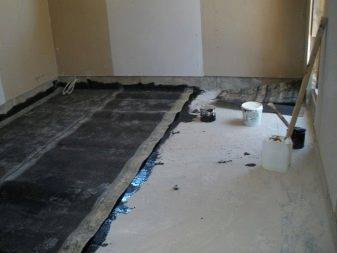
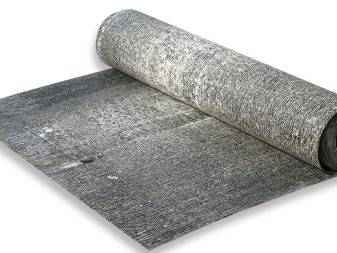
The roofing material has the lowest performance characteristics. The material consists of cardboard impregnated with bitumen, therefore it has low strength and limited service life. Fastening of rolled materials is carried out using an adhesive composition, which is used as bitumen and polymer mastics, and by heating the surface with open flame burners.
Shield materials are represented by polyurethane shields and bentonite mats, the installation of which is carried out with anchors or dowel-nails. From above, mats and shields are covered with special moisture-repellent mastics with a particularly careful sealing of the joints. Panel technology is used in industrial and commercial premises and is not used for waterproofing living spaces.
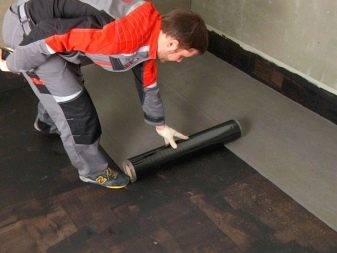

Granular materials are poured under the screed or finishing wood flooring and are fine-grained polymer or sand-containing mixtures that reliably prevent moisture penetration. The advantage of the materials is a fairly high degree of moisture protection, the disadvantages include a decrease in the height of the room, which is due to the installation technology and averages 30 cm.
Liquid materials are used for painting waterproofing and are represented by liquid glass, epoxy compounds, varnishes and paints. The advantage of this group is the ease of application and the availability of the formulations.
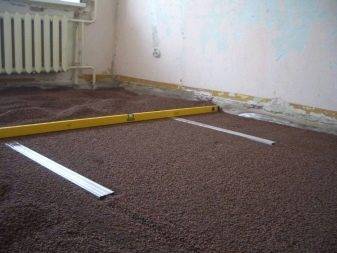
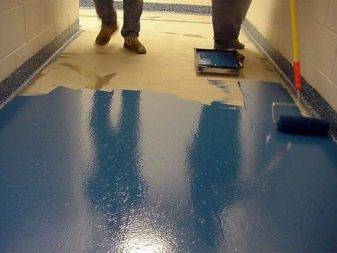
Liquid materials can be conventionally classified into deep penetration compositions, for example, "Penetron", which provide anti-corrosion protection of metal floor elements, and into agents that form a waterproof film on the surface of the rough base. The latter not only perform an anti-corrosion function, but can also be used as an anti-filtration barrier to prevent leakage. Their disadvantage is the loss of performance of the material over time, for example, the appearance of cracks on a painted or varnished surface.
Dry mixes for self-leveling floors are self-leveling compounds that form a smooth hermetic layer of the required thickness and provide reliable protection of the floor and lower rooms from moisture penetration. The advantage of the material is the possibility of making a sufficiently effective waterproofing with your own hands, and the disadvantages include high labor costs and a long installation time.


Classification by type of main component
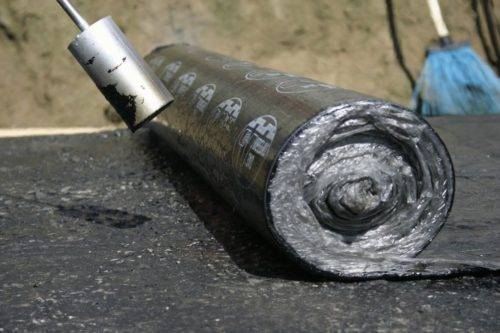
Bituminous waterproofing is a universal and most affordable way to protect the elements of a structure from moisture. Bitumen is absolutely impervious to moisture. High-quality bituminous waterproofing, as well as related products, can be purchased at the GidroiSOL store.
Metal waterproofing is a continuous fence made of steel sheets, joined together by welding, and with an insulated structure - with anchors embedded in concrete. It is very strong, waterproof under high water pressures and durable under certain operating conditions. However, its installation is expensive and laborious. Polymer waterproofing is made using a bitumen emulsion with the addition of latex, polyurethane, cement, acrylic, epoxy resins, rubber or polystyrene.
Mineral waterproofing is a mixture of quartz sand and Portland cement-based polymers. The composition protects well against moisture penetration, provides good adhesion to the surface and greater reliability.In addition, the material has a long service life.
Interesting! The disadvantages of this type include excessive rigidity. In case of shrinkage of the base, the waterproofing layer will crack, breaking the tightness. In addition, the materials are vapor permeable
Therefore, they cannot be used in cases where it is important to maintain the microclimate.
Views
Waterproofing materials are found very often in both domestic and industrial construction. The high demand for these products has led to the emergence of many varieties of protective substances. Depending on the structure of the manufactured product, it is divided into several types.
- Leafy. Waterproofing of this type is available in sheets of various sizes. Such products are used to cover concrete foundations and other bases with relatively standard dimensions.
- Roll. The materials are versatile and are used almost universally. Rolls can be from 1 to 2-3 m wide, depending on the manufacturer. The length of such a product is not regulated by standards, so it varies in a very wide range.
- Tiled. Such products are used relatively rarely. But if you choose it correctly, you can get relatively good results.
Depending on the method of application, waterproofing is classified as glued or self-adhesive. Certain types of products can be classified as glued materials.
- Roofing material. Bituminous substances based on building board. The cheapest and easiest type of insulation.
- Hydroizol. The product consists of fiberglass or asbestos base on oxidized bitumen mastic. Produce coatings with sprinkling or double-sided polymer protective layer.
- Glass insulation. This waterproofing is very similar in structure to the previous type. As protective components, a layer of glass insulation with several types of polymers is introduced into it.
- Isol. This material does not use a substrate, it consists only of bitumen and various types of rubbers. It is used for waterproofing underground structures.
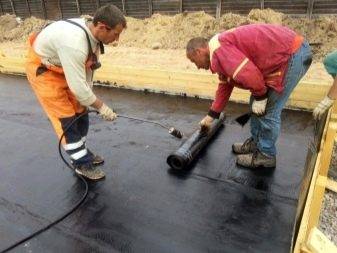
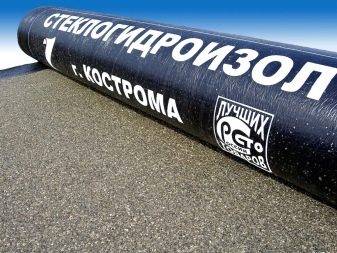
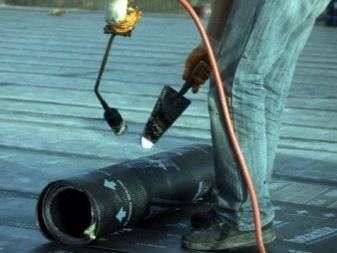
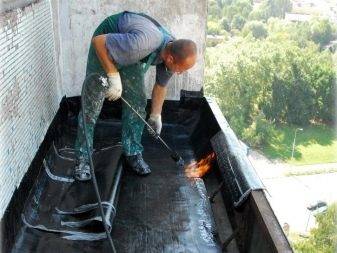
Among the self-adhesive waterproofing, several types of products should be distinguished.
- TechnoNIKOL. It is based on a bitumen-polymer component, which is protected by a special polymer and adhesive layer. Membranes are used in the arrangement of warm floors.
- Technoelast. The structure of the substance resembles the previous type of product. But it is recommended to use it for floor screeds.
- Membrane Giscolene 120 Peel & Stick. Waterproofing is made of synthetic rubber. Butyl is used as a self-adhesive layer. The substance is very good at preventing moisture penetration. It is often used when arranging roofs.

